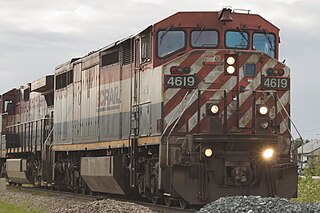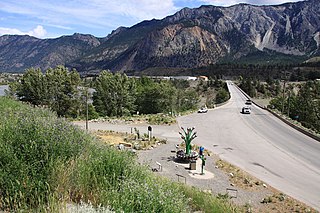Related Research Articles

Lillooet is a district municipality in the Squamish-Lillooet region of southwestern British Columbia. The town is on the west shore of the Fraser River immediately north of the Seton River mouth. On BC Highway 99, the locality is by road about 100 kilometres (62 mi) northeast of Pemberton, 64 kilometres (40 mi) northwest of Lytton, and 172 kilometres (107 mi) west of Kamloops.

The British Columbia Railway Company, commonly known as BC Rail, is a railway in the Canadian province of British Columbia.

The following is an alphabetical list of articles related to the Canadian province of British Columbia.

Lytton is a village of about 250 residents in southern British Columbia, Canada, on the east side of the Fraser River and primarily the south side of the Thompson River, where it flows southwesterly into the Fraser. The community includes the Village of Lytton and the surrounding community of the Lytton First Nation, whose name for the place is Camchin, also spelled Kumsheen.
The 1871 British Columbia general election was held from October to December 1871. Formerly a British colony, British Columbia became a province of Canada on July 20, 1871. An interim Cabinet was appointed by the lieutenant governor of British Columbia and election writs for the first general election as a province of Canada were issued to choose 25 members of the first provincial legislature from 12 ridings. These ridings were:

A quiggly hole, also known as a pit-house or simply as a quiggly or kekuli, is the remains of an earth lodge built by the First Nations people of the Interior of British Columbia and the Columbia Plateau in the United States. The word quiggly comes from a mispronunciation of the nsyilxcǝn term qʷc̓iʔ, which was incorporated into Chinook Jargon as kickwillie. Kick willy, kickwillie, or keekwulee are the spelling variations of the Chinook Jargon word for "beneath" or "under".
Cariboo was one of the twelve original electoral districts created when British Columbia became a Canadian province in 1871. Roughly corresponding to the old colonial electoral administrative district of the same name, it was a three-member riding until the 1894 election, when it was reduced through reapportionment and became a two-member riding until the 1916 election, after which it has been a single-member riding. It produced many notable Members of the Legislative Assembly (MLAs), including George Anthony Boomer Walkem, third and fifth holder of the office of Premier of British Columbia and who was one of the first representatives elected from the riding; John Robson, ninth Premier of British Columbia; and Robert Bonner, a powerful minister in the W.A.C. Bennett cabinet, and later CEO of MacMillan Bloedel and BC Hydro.
The In-SHUCK-ch Nation, also known as Lower Lillooet people, are a small First Nations Tribal Council on the lower Lillooet River south of Pemberton-Mount Currie in the Canadian province of British Columbia. The communities of the In-SHUCK-ch are of the St'at'imcets-speaking St'at'imc people, but in recent years seceded from the Lillooet Tribal Council to form their own organization. The name In-SHUCK-ch is taken from In-SHUCK-ch Mountain, a distinctive mountain near the south end of Lillooet Lake.

Clinton is a village in British Columbia, Canada, located approximately 40 km (25 mi) northwest of Cache Creek and 30 km south of 70 Mile House.
Xaxli'p, also known as the Fountain or the Fountain Indian Band, is a First Nations government located in the Central Interior-Fraser Canyon region of the Canadian province of British Columbia. It is a member of the Lillooet Tribal Council, which is the largest grouping of band governments of the St'at'imc people.

The Legislative Council of British Columbia was created in 1867 for the governor of the "new" United Colony of British Columbia. The merged colony had not theretofore had a responsible government, and its executive power was only it's governor, who at the time of its Legislative Assembly's founding was Frederick Seymour.

The Lakes Route is an alternate name for the Douglas Road, which was the first formally designated "road" into the Interior of British Columbia, Canada, from the Lower Mainland area flanking the Lower Fraser River. Also known as the Douglas-Lillooet Trail or the Lillooet Trail, the route consisted of a series of wagon roads connected via lake travel in between. A variety of craft propelled by a variety of means, from steam to sail to diesel and other combustion engines, were used on the lakes into the early 20th century. Lake travel continued for commerce, passenger travel, and heavy freight until after World War II.

Gustavus Blin Wright was a pioneer roadbuilder and entrepreneur in British Columbia, Canada. His biggest achievement was building the Old Cariboo Road to the Cariboo gold fields, from Lillooet to Fort Alexandria, but he was also a partner in a freighting firm that operated on the Douglas Road, he ran a toll bridge at Bridge River, near Lillooet, and built part of the road from Quesnel to Barkerville. He was also the original owner of the town of 70 Mile House.

Bridge of the Twenty-Three Camels is the official name of the highway bridge over the Fraser River at Lillooet, British Columbia, Canada, on BC Highway 99. It replaced the older 1913-vintage Lillooet Suspension Bridge, just upstream, which had no highway designation but connected the town to BC Highway 12, a designation which today only refers to the Lillooet-Lytton highway but, until the extension of the 99 designation from Pemberton, also included the Lillooet-Cache Creek highway.
Henry Holbrook was an English-born merchant and political figure in British Columbia. He represented New Westminster City in the Legislative Assembly of British Columbia from 1871 to 1875.
Thomas Basil Humphreys was an English-born miner, auctioneer and political figure in British Columbia. He represented Lillooet from 1871 to 1875, Victoria District from 1875 to 1882 and Comox from 1887 to 1890 in the Legislative Assembly of British Columbia.
Reginald Hayward was a funeral director and political figure in British Columbia. He represented Victoria City in the Legislative Assembly of British Columbia from 1924 to 1933 as a Conservative. Hayward was Mayor of Victoria from 1922 to 1924.
The Legislative Council of British Columbia held its first election in 1866. BC was a colony formed by the union of the colony of Vancouver Island and the colony of British Columbia.
Alfred Walter Toone was a Canadian politician, who served as mayor of Victoria, British Columbia, in 1966. He died in office of a heart attack.
References
- ↑ "Mayors (By Date)". victoria.ca. Archived from the original on 18 July 2014. Retrieved 15 July 2014.
- ↑ "Political Notes". Lillooet Prospector. Lillooet, British Columbia. 21 July 1916. Retrieved 3 January 2025– via University of British Columbia Library Open Collections: BC Historical Newspapers.